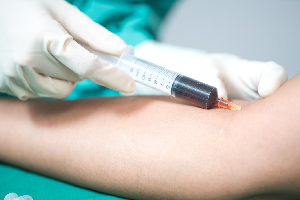Frequently Asked Questions About RHD Genotyping
Download and read the Sandler et al. study

Expectant mothers routinely receive serologic testing to determine if they carry the Rh antigen D (RhD) in their red blood cells (RBCs). This testing is necessary because complications can arise during pregnancy when the mother’s Rh type doesn’t match that of the fetus. Specifically, a mother who is RhD-negative can produce RhD antibodies in response to an RhD-positive fetus, which could cause hemolytic disease of the fetus and newborn (HDFN). Antepartum and postpartum treatment with Rh immune globulin (RhIG) is the standard treatment in these cases, which prevents maternal sensitization to RhD.
This conservative approach can result in excess usage of RhIG which, in turn, poses concerns around unnecessary administration of a human blood product, which is also in limited supply. RHD genotyping can reduce this risk. Below, we answer the most frequently asked questions about this test.
What is the weak RHD genotype?
RhD blood typing is effective in identifying the RhD status of approximately 94 percent of patients. However, the results are not straightforward e in two to six percent of cases due to genetic differences in RHD. In these individuals, the serologic test can indicate an Rh-positive or Rh-negative result, depending on the specific test. This inconsistency is due to variations in the RHD gene that affect the expression of the RhD antigen on RBCs.
Serologic testing may not detect lower concentrations of RhD or altered RhD protein on the surface of RBCs. However, genotyping provides conclusive results for RhD typing of patients.
What are the benefits of RHD genotyping?
A 2015 publication from Sandler et al. suggests that about 13,360 expectant mothers receive RhIG treatment unnecessarily in the United States each year, resulting in the administration of an estimated 24,700 doses of RhIG that aren’t needed. The improved accuracy of RHD genotyping over serologic testing prevents the unnecessary use of RhIG, which is a human blood product with limited availability, and eliminates the need for postpartum typing of the mother and newborn.
With RHD genotyping, healthcare providers can confidently know which patients are at risk and require prophylaxis.
Is RHD genotyping efficacious?
RHD genotyping is the only definitive method of identifying individuals with weak or altered RhD phenotypes Roussel M et al. Patients who are homozygous or hemizygous for weak D types 1, 2 and 3 may be safely classified as RhD-positive, meaning their immune systems won’t produce alloanti-D when exposed to RhD-positive RBCs. Individuals with partial D types, on the other hand, are at risk for clinically significant sensitization and should be treated as RhD-negative for transfusion and candidates for Rh immune globulin if the fetus is RhD-positive.
About 95 percent of Caucasian patients of European descent with weak D phenotypes are weak D types 1, 2 or 3. However, patients with other ethnic backgrounds may have other RHD variants.
The College of American Pathologists (CAP) and American Association of Blood Banks (AABB) recommends RHD genotyping on patients with a serologic weak D phenotype or inconclusive results who are at risk for clinical complications if alloimmunized to the RhD antigen following exposure to RhD-positive RBCs. These risk groups include pregnant women and females of child bearing potential who require transfusion.
Is RHD genotyping cost-effective?
RHD genotyping provides clinical value for the management of obstetrics patients without increasing the financial burden to the healthcare system. In 2015, Kacker et al. estimated the financial cost of performing RHD genotyping on obstetric patients with serologic weak D phenotypes across the entire healthcare system.
The model compared the total cost of RHD genotyping and treatment for patients with serologic weak D phenotypes at risk for alloimmunization against the cost of the traditional strategy of treating all of these patients with Rh immune globulin (RhIG). It considered both the cost of RHD genotyping and the savings of the RhIG product and administration and testing the baby and the mother post-delivery. This model predicted that RHD genotyping would result in a net savings of $645,034 over ten years, increasing to $2.01 million over 20 years.
Which patients should receive RHD genotyping?
It’s currently impractical to perform RHD genotyping on all patients until high throughput methods are routinely available.
CAP and AABB Work Group estimated that genotyping would identify 13,360 women with weak D Types 1, 2 and 3 of the 3.95 million live births that occur annually in the U.S. This would eliminate about 24,700 unnecessary injections of RhIG each year. Similarly, genotyping the five million people who receive blood transfusions annually would identify about 17,250 individuals who could safely receive 47,700 units of RhD-positive blood instead of RhD-negative blood. The Work Group recommended that RHD genotyping be performed on pregnant women and those of child bearing potential who need a transfusion if their RhD typing results are inconclusive.
For more on RHD genotyping, including its potential financial implications, download and read "Financial implications of RHD genotyping of pregnant women with a serologic weak D phenotype" by Kacker et al. (2015) here.
